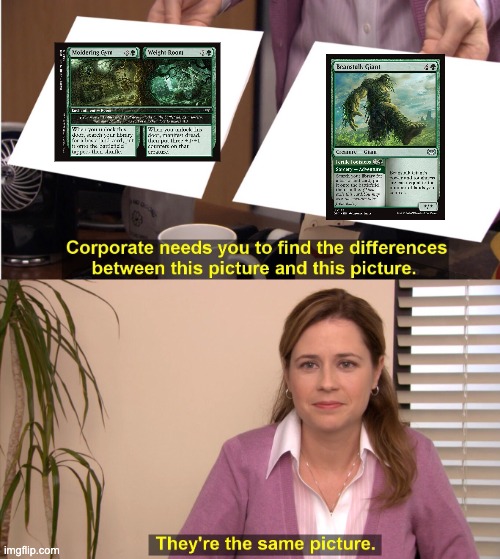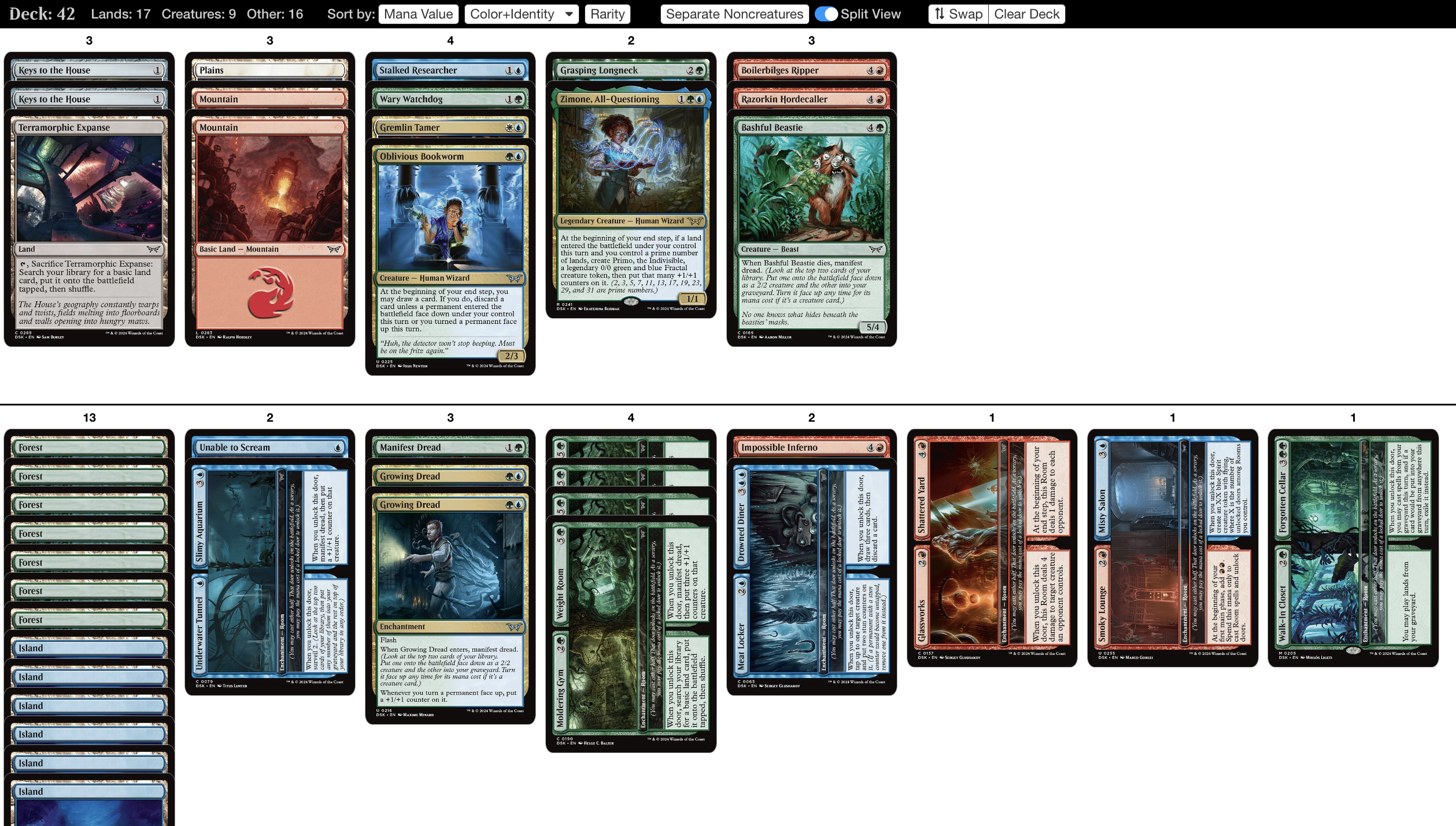Making Room for Value
09/16/2024
Duskmourn is fast approaching! Early access is this week, prerelease is this weekend, and the set goes live online next week. And with this set being the draft format for Worlds in late October, I'm going to be playing a lot of this set to prep.
As part of that, I've actually already done some drafts! This weekend I got together with some of my Worlds teammates for four drafts, and played some games to boot. And throughout all of those drafts, I was consistently impressed with the new mechanic: Rooms.
So, today I'm going to talk all about how Rooms play out, what implications that has for the format, and how best to build your deck to take advantage of Rooms.
Part 1: Higher Synergy Adventures
Rooms are a new mechanic in Duskmourn that are yet another implementation of split cards.
The most natural comparison would to Rooms would be Adventures: they have two halves that you can cast, one or both of which tend to be somewhat inefficient effects. And, importantly, both of these mechanics let you cast both halves of the spell, not just one - inherently representing some degree of card advantage.

corporate needs you to find the difference between Moldering Gym / Weight Room and Fertile Footsteps / Beanstalk Giant
However, there are two big differences between Rooms and Adventures: on one hand, Rooms produce creatures much less often than Adventures; but on the other hand, you can cast Rooms in either order and still get both sides, whereas casting the creature half of an adventure first locks you out of casting the spell half.
So, in both of these respects, Rooms are much more oriented towards lategame value, as they are relatively inefficient at affecting the board.
Rectangle Theory
Another small benefit that Rooms have over Adventures is that they are permanents that stick on the battlefield as pieces of cardboard you can interact with.
Of course, you can also utilize Adventure creatures by interacting with the creature body it becomes - but in that case, you often need to give up that board impact to do so. Bouncing or sacrificing an Adventure creature will put you down on tempo; whereas bouncing or sacrificing a Room will not.
There's even cards that call out to this! One card -
Intruding Soulrager - explicitly mentions sacrificing rooms; but there are many others besides that can sacrifice or bounce them for value ( Boilerbilges Ripper, Fear of Isolation, Get Out).Eerie Density
Finally, Rooms play extremely well into another new mechanic in the set: Eerie.
This mechanic is essentially the enchantment version of Landfall - it triggers whenever an enchantment enters under your control. Except, it also triggers when you fully unlock a Room - so each Room has the potential to trigger Eerie twice!
This seems somewhat small, but actually it has a huge effect on how Eerie plays. Usually, when you have a mechanic like Eerie that cares about a certain kind of card and gets better every time you play a card of that kind, the limiting factor is how many copies of that kind of card you can shove into your deck. But with Rooms, you can effectively get double the density.
We actually Learned this Lesson already in Strixhaven - where Magecraft triggers like those on
Eager First-Year or synergy requirements on cards like Serpentine Curve were turbocharged by the fact that Learn spells represented not one but two instants or sorceries cast.Eerie and Rooms in Duskmourn will likely play out similarly - because every Room counts twice for Eerie, you're going to be able to trigger Eerier much more consistently than you might expect, for much longer into the game.
Part 2: Building a Mansion
So how best can we take advantage of the power that Rooms provide?
Well, the property I want to focus on is that Rooms represent specifically a lot of lategame power, concentrated into fewer card slots than usual. So, you don't need to dedicate any other parts of your deck to winning the lategame - you can focus the rest of it almost entirely on defensive speed instead.
One simple way to look at this is to consider the sheer amount of mana you can spend on Rooms. All of them cost at least 5 mana to fully unlock, and
quite a few of them cost upwards of 8-9 mana to get all the value from. And unlike Adventures, even playing the more-board-impacting side of a Room will still leave you with the other half sitting around waiting to be unlocked.On top of that, many of the
board-affecting rooms make creatures by manifesting dread, which is yet another potential mana sink! So, having many Rooms should make sure your lategame is fully set - any additional lategame is much more likely to compete and provide marginal upgrades, rather than offer anything you were missing.Because of this, you probably just won't need to play cards like
Glimmerburst. While a card like that can do a fine job in a vacuum of straddling lategame and defense - a draw 2 helping you keep up your card flow, while at the same time using the Glimmer token to not fall too far behind - it's extremely antisynergistic with Rooms. When you're playing a bunch of Rooms, you don't need more things to spend mana on. And while in most controlling decks the extra board impact is nice, in a deck trying to take advantage of Rooms you'd much, much rather just have something that efficiently impacts the board for you.Fundamentally, the philosophy of Rooms is one of specialization: Rooms are extremely specialized towards the lategame, and so play best when paired with cards that are similarly extremely specialized for the early game. Cards like Glimmerburst whose power is in flexibility have no place here.
Instead, defensive speed is key! Play cheap efficient blockers, like
Stalked Researcher or Grasping Longneck. Play cheap removal, like Scorching Dragonfire or Unable to Scream. Play cards that let you spend your mana to efficiently impact the board in the early game, to balance against your Rooms that let you spend copius amounts of mana inefficiently in the lategame.Finally, you cannot build a mansion without having a lot of land. Rooms are extremely mana hungry! And again, since they condense spell slots by being two spells in one card, you can afford to simply play fewer nonland cards. If you squint, 5 rooms and 15 other cards adds up to 25 spells instead of the normal 20 - though of course this is an oversimplification, and I doubt you'd ever want to go to quite that extreme of a split. But certainly consider playing upwards of 18 or 19 mana sources, especially if some of those mana sources have other uses as well.
Part 3: Izzet vs Simic
Nominally, the rooms archetype is Izzet. Blue and red both have two Rooms at common and one at uncommon; whereas the other three colors only have one at common and one at uncommon. Plus, UR as a color combination has the only two-color Room at uncommon.
However, looking at the blueprints I laid out above, it kind of seems that green is a bit more fitting as a Rooms-focused deck than red is. Yes, red has soome good rooms and good cheap removal - but those can be splashed. And what red is missing is good defensive speed - a lot of the good red creatures are more focused on attacking well.
Green, on the other hand, has what I believe is the best common Room for a Rooms deck in
Moldering Gym - as the ramp and fixing provided by this Room really helps you get more value from your Rooms. And on top of that, it has three really nice 2-drops at common to provide good defensive speed, with Grasping Longneck at 3 mana as well for reaching defense and incidental lifegain!And on top of all that, green is the best color at helping make sure that you hit every single land drop. Between cards like
Spineseeker Centipede and Moldering Gym, you can consistently develop your mana in many different colors to let you successfully make good use of all of your Rooms.Don't get me wrong, Izzet still seems like a fine place to play some amount of Rooms! Red just seems to push in a completely different direction, and a lot of the red rooms mirror this by having one half that has immediate impact, and another half that gives small but aggressive continuous value.
Izzet looks much more setup to be a tempo-y, sac-Rooms-for-value space to me - at least, that's the direction that
Intruding Soulrager points towards. And in that sense, Izzet probably will enjoy playing Rooms as just good cards with incidental value with leaving behind cardboard to sacrifice, but not really leaning into them as a major gameplan. I wouldn't expect to be spending too much mana on slow rooms - basically, I think Smoky Lounge looks kind of awkward in this kind of archetype.So, perhaps unsurprisingly, this leaves me to believe that green-based-soup will be the best home for a slower, grindier Room gameplan. Izzet will be a fine home for the red Rooms, but many of the blue Rooms seem more suited to Simic.
Conclusion - Example Draft
One of my favorite draft decks from this past weekend was this extremely grindy UGrw Rooms deck.

one of the sweetest decks I've ever drafted
Here you can see me putting the above ideas into action: my deck consists almost entirely out of defensive speed (7 two-drops and a
Grasping Longneck), interaction ( Unable to Scream and Impossible Inferno), and Rooms. I'm playing effectively 19 lands, as I have roughly infinite use for mana sources (including two of those lands being Keys that can also double as spells). And I just... don't need any other way to "close out" the game really - the three 5-drops I'm playing are just there as pretty nice things to curve into with three copies of Moldering Gym.Amusingly enough, I'm playing more than 40 cards here - 42 to be exact - both because I wanted a way to fit two mountains and a plains for my basic-searching without diluting my main UG manabase; and because ultimately this deck is actually quite prone to running out of cards.
And one final note to end on - this deck actually has an infinite value engine! And that's not just an exaggeration:
Keys to the House and Walk-In Closet actually provide infinite recursive value over the course of many turns, where the only real limit is how much mana you can spend.Basically, the idea is that Keys can re-lock the Cellar without getting exiled, as long as you haven't yet unlocked the Cellar that turn. So, if you start a turn by locking the Cellar with Keys, then paying to unlock it, then you can proceed to cast as many permanent spells from your graveyard as you wish without them being exiled - including the Keys you used to lock the Cellar!
This of course costs a lot of mana - 9 mana total just for the basic loop structure (1 to play Keys, 3 to lock Cellar, and 5 to unlock Cellar). But Closet should hopefully mean you never miss a land drop and can therefore eventually have enough mana to let this engine overpower any lategame; and you can also split up the mana by locking the Cellar the turn before you unlock it, instead of on the same turn.
The sheer amount of mana required for this loop means it's not going to be relevant in most games. But, the fact that it's an option that's open to this deck at all just gives this deck so much inevitability, which can be useful in slower matchups.
It's really the extreme end of the philosophy of Rooms - your Rooms will give you all the lategame power you could ever ask for, condensed into a relatively small number of card slots, so the entire rest of your deck should be focused purely on getting to that lategame.
#FreePalestine | Consider donating to UNWRA or PCRF, supporting protesters locally, and educating yourself.
